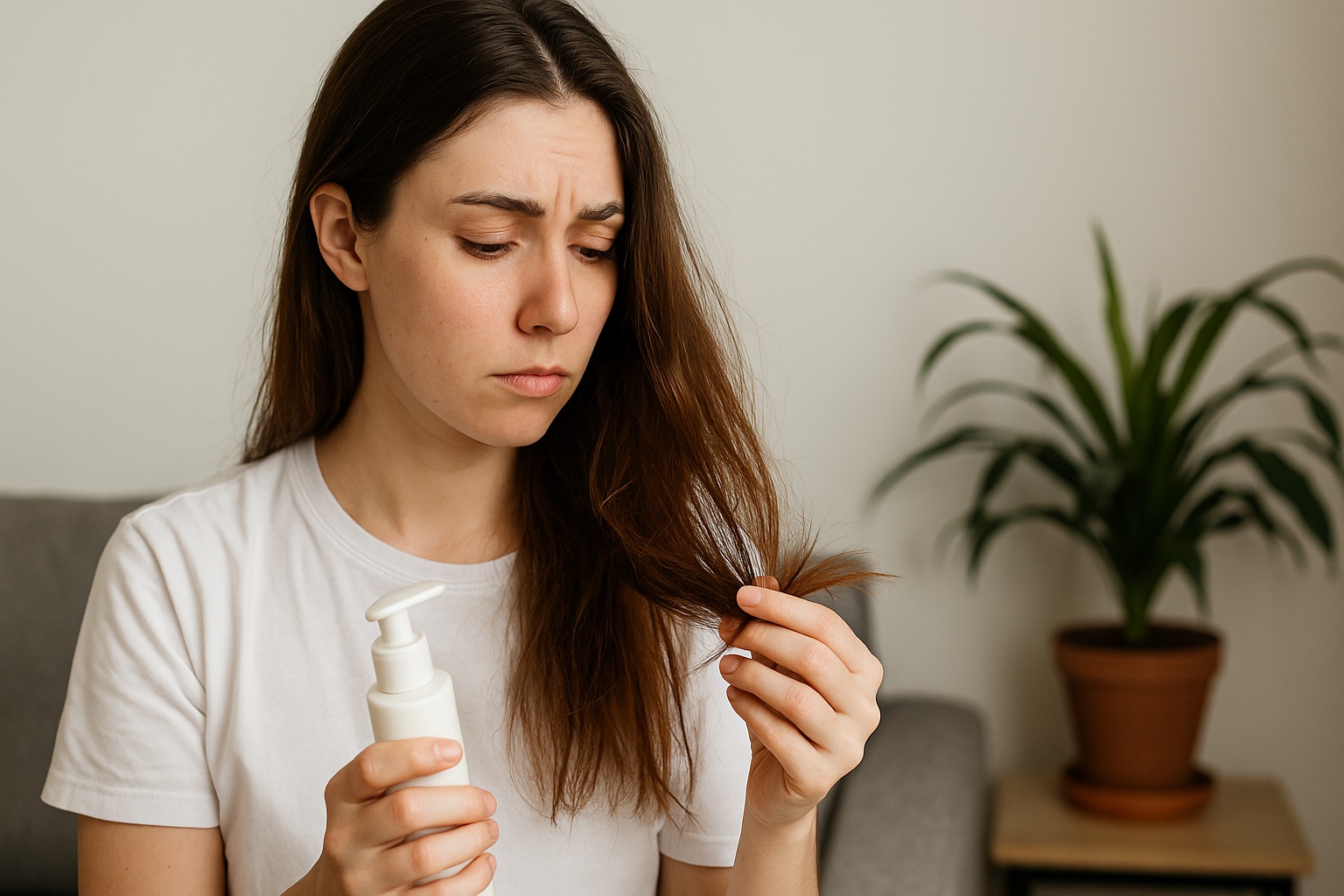Hair looks healthy when the cuticle, the outer protective layer, is smooth and intact. Once that layer is lifted, cracked, or stripped away, the strand loses moisture and strength. That’s when people say their hair is “damaged.” In simple terms, damaged hair means the inside structure of the strand—the protein bonds and moisture balance—has been weakened.
Damage can happen in many ways. Heat from flat irons or blow dryers, chemical treatments like bleaching or coloring, mechanical stress from brushing or tight hairstyles, dryness from lack of moisture, and even environmental factors such as sun, pollution, and hard water all take their toll. Over time, this shows up as split ends, frizz, dullness, or breakage.
The good news is that damaged hair is not the end of the road. While you can’t “magically heal” a broken strand, you can restore smoothness, reinforce bonds, and bring back shine and manageability with the right approach. In this guide, I’ll walk you through how to repair damaged hair step by step—covering fast fixes you can do at home, deeper treatments for long-term results, and smart habits that prevent further harm.
- Understanding The Damage: Types, Causes & Signs
- Expert Insights: What Happens Inside The Hair Shaft
- How To Repair Damaged Hair Fast At Home
- Long-Term Repair & Maintenance
- How To Repair Dry Damaged Hair
- Common Myths & Mistakes To Avoid
- Related Repair Methods For Different Types Of Damage
- Practical Tips For New Parents
- Conclusion
Understanding The Damage: Types, Causes & Signs
Before you can fix damaged hair, you need to understand what kind of damage you’re dealing with. Not all damage looks the same, and different causes need different solutions.
Types Of Hair Damage
Heat Damage
Frequent use of blow dryers, flat irons, or curling wands weakens the hair’s natural protein bonds. This leaves strands brittle, dry, and prone to breakage. You may notice your hair feels rough, loses its natural curl pattern, or looks straw-like after styling.
Chemical Damage
Bleaching, dyeing, relaxing, and perming strip the hair of its protective layers. Chemicals penetrate deep into the cortex, breaking down the bonds that give hair strength. The result is often thinning, rough texture, and extreme dryness.
Mechanical Damage
Everyday habits like aggressive brushing, tight ponytails, or rubbing hair with a towel can physically wear down the cuticle. Over time, this causes split ends, frizz, and weak points along the strand that snap easily.
Environmental Damage
The sun’s UV rays, pollution, wind, and even minerals from hard water can break down hair’s natural defenses. This damage often shows as faded color, rough texture, or a dull appearance.
Dryness-Related / Dehydration Damage
When hair lacks proper moisture, it becomes stiff and fragile. This is often linked to porosity issues, where the cuticle doesn’t hold onto hydration well. The result is frizz, breakage, and hair that feels constantly dry no matter how much conditioner you use.
How to Tell If Your Hair Is Damaged
Common Signs
Look out for split ends, brittle texture, frizz, dull or faded color, and hair that breaks easily when brushing. Another giveaway is loss of elasticity—healthy hair can stretch slightly and bounce back, while damaged hair snaps quickly.
Simple Tests
- Porosity Test: Place a clean strand of hair in a glass of water. If it sinks quickly, your hair is highly porous and likely damaged.
- Elasticity Test: Gently stretch a strand. If it doesn’t spring back, that’s a sign of weak internal bonds.
- Strand Check: Under bright light or with a magnifier, damaged cuticles look rough, uneven, or frayed.
Severity Levels
- Mild Damage: Dryness, slight frizz, occasional breakage. Can usually be managed with home treatments.
- Moderate Damage: Noticeable dullness, split ends, loss of strength. May need targeted masks and regular trims.
- Severe Damage: Breakage in clumps, gummy texture when wet, or chemical burns. This level often requires professional treatments or cutting off the worst parts.
Expert Insights: What Happens Inside The Hair Shaft
To truly understand how to repair damaged hair, it helps to know what’s happening on a deeper level. Hair isn’t just one solid piece—it’s a complex structure made of layers and bonds that work together to keep it strong and flexible.
The Structure Of A Hair Strand
- Cuticle: The outermost layer made of overlapping “scales.” This layer protects the inner parts of the hair. When it’s smooth and intact, hair looks shiny and healthy. When it’s lifted or broken, hair becomes rough, tangled, and prone to damage.
- Cortex: The middle layer, packed with keratin proteins and natural pigments. The cortex gives hair its strength, color, and flexibility. Most chemical and heat damage happens here.
- Medulla: The innermost core (not present in all hair types). While it doesn’t affect appearance much, it contributes to overall structure in thicker strands.
The Bonds That Hold Hair Together
Inside the cortex, there are tiny bonds that act like glue. These include:
- Hydrogen Bonds – Easily broken by water or heat (why hair changes shape when wet or styled).
- Disulfide Bonds – Strong sulfur bonds that give hair its structure. Chemical treatments like perms or relaxers break and reform these.
- Ionic/Salt Bonds – Sensitive to changes in pH levels from shampoos, treatments, or chemical processes.
When too many of these bonds are broken and not repaired, hair loses its elasticity, becomes weak, and eventually breaks.
The Role Of Moisture And Natural Oils
Sebum (the natural oil from your scalp) coats the cuticle and keeps it flexible. When this layer is stripped—by harsh shampoos, overwashing, or chemical treatments—the cuticle becomes exposed. Without moisture, the cortex inside becomes dry and brittle.
How Genetics And Health Play A Role
- Genetics decide your natural hair thickness, curl pattern, and resilience.
- Nutritional deficiencies (like lack of protein, iron, or vitamins) weaken hair growth.
- Hormonal shifts (like pregnancy, postpartum, or stress-related imbalances) can make hair more fragile and prone to damage.
How To Repair Damaged Hair Fast At Home
You don’t always need expensive salon treatments to start repairing damaged hair. With the right habits and products, you can make a big difference at home. Think of these steps as “first aid” for your strands—quick ways to restore softness, shine, and manageability.
Immediate First-Aid Fixes
Trim Split Ends
Split ends can’t be glued back together. The only real fix is trimming them off. Even a small trim removes the weakest points and stops splits from traveling further up the hair shaft.
Switch to Gentle Tools
Ditch rough brushes, tight elastics, and cotton towels. Instead, use wide-tooth combs, silk scrunchies, microfiber towels, and satin pillowcases. These reduce friction and keep cuticles smoother.
Apply Leave-In Treatments
A leave-in conditioner or serum coats the hair, smoothing rough cuticles instantly. Look for formulas with lightweight oils, proteins, or silicone alternatives that lock in moisture and add shine.
Deep Treatment At Home
Use a Repair Mask Weekly
A deep conditioning mask provides a concentrated dose of hydration and nutrients. For damaged hair, alternating between protein-based masks (to strengthen bonds) and moisture-based masks (to restore softness) gives the best results.
Try Nourishing Oils
Coconut oil, argan oil, and jojoba oil are excellent for sealing in moisture and reducing breakage. Warm a few drops in your hands and apply from mid-lengths to ends as an overnight treatment or pre-wash oiling.
Bond-Building Products
Some at-home treatments are designed to rebuild broken disulfide bonds in the cortex. These are especially effective for chemically treated or heat-damaged hair. Use them sparingly and follow instructions closely.
How To Repair Heat-Damaged Hair
Reduce Heat Usage
Give your hair “rest days” from straighteners, curling irons, and blow dryers. If you must style, use the lowest temperature that works and limit how often you apply heat.
Always Use Heat Protectant
A heat protectant spray or cream creates a protective barrier that reduces moisture loss and cuticle damage. This step is non-negotiable if you use styling tools.
Safer Styling Techniques
- Never use hot tools on wet hair (this causes steam damage inside the strand).
- Choose ceramic or tourmaline plates for smoother results.
- Air-dry when possible, or use a diffuser on a low-heat setting.
By combining these simple home steps, you can start to see real improvements in the look and feel of your hair in just a few weeks.
Long-Term Repair & Maintenance
Fast fixes can smooth the surface, but long-term repair comes from consistency. The goal is to strengthen the inner structure, maintain hydration, and prevent new damage.
Build A Consistent Hair Care Routine
- Gentle Cleansing
Wash your hair with a sulfate-free shampoo that won’t strip natural oils. Frequency depends on your hair type—oily hair may need more washing, while dry or curly hair benefits from fewer washes. - Condition Every Time
Follow up with a conditioner after every shampoo. Conditioners seal the cuticle, replace lost moisture, and make detangling easier. - Regular Deep Treatments
Plan a weekly or bi-weekly deep conditioner or hair mask. Alternate between strengthening masks (with keratin, proteins, or amino acids) and hydrating masks (with oils, butters, or humectants). - Protective Styling
Looser hairstyles reduce tension on the scalp and strands. Braids, buns, or silk scarves can protect hair from breakage while still looking stylish.
Nutrition, Lifestyle & Scalp Health
- Nutrition Matters
Hair is mostly made of protein, so a protein-rich diet supports stronger growth. Include eggs, fish, beans, nuts, and leafy greens. Vitamins A, C, D, E, biotin, zinc, and omega-3s all play important roles in scalp and hair health. - Hydration & Rest
Drinking enough water and getting good sleep keep the body balanced, which shows up in your hair. Stress management is just as important—high cortisol levels can weaken hair and increase shedding. - Scalp Care
A healthy scalp equals healthier hair. Gentle exfoliation (with scalp scrubs or clarifying shampoos) removes buildup. Light scalp massages boost blood circulation, helping deliver nutrients to the roots.
When To Seek Professional Help
- Severe Damage
If your hair feels gummy when wet, breaks off in clumps, or shows signs of chemical burns, professional intervention is needed. - Salon Treatments
Options include bond-repair systems, keratin treatments, and hair botox. These reinforce internal structure, smooth cuticles, and restore manageability. - Regular Trims
Even with the best care, damaged ends need to be trimmed every 6–8 weeks. A professional stylist can shape your hair while removing weak, frayed parts.
This section reassures readers that repairing damaged hair isn’t just about quick products—it’s about building habits that keep their hair strong for the future.
How To Repair Dry Damaged Hair
Dryness is one of the most common forms of damage. When hair can’t hold onto moisture, it becomes rough, brittle, and hard to style. The key here is not just adding hydration but also teaching the hair to retain it.
Focus On Moisture-Rich Products
- Moisturizing Shampoos & Conditioners
Choose formulas with humectants like glycerin, hyaluronic acid, or aloe vera. These pull water into the hair shaft and help it stay hydrated. - Creamy Deep Conditioners
Look for ingredients like shea butter, argan oil, or fatty alcohols (cetyl, stearyl). These soften and smooth the cuticle, locking in moisture.
Lock In Hydration With Oils
Applying a lightweight oil after conditioning helps seal the cuticle. Argan, almond, or grapeseed oil are excellent for dry hair because they smooth the surface without weighing it down.
Night Care & Protective Habits
- Overnight Treatments
Apply a leave-in cream or oil blend before bed and cover hair with a silk scarf or bonnet. This prevents moisture from escaping and protects from friction. - Protective Styles
Loose braids, twists, or buns keep hair from tangling and breaking while you sleep.
Avoid Harsh Practices
- Skip harsh clarifying shampoos unless there’s serious buildup.
- Reduce the use of heat styling tools. If you must use them, always apply a heat protectant.
- Avoid washing with very hot water—it strips oils and makes dryness worse.
Consistency Over Quick Fixes
Dry hair won’t improve overnight. It takes weeks of regular conditioning, oiling, and gentle handling to notice real change. Stick with a routine, and your hair will gradually regain softness and shine.
Common Myths & Mistakes To Avoid
When it comes to repairing damaged hair, there’s a lot of confusing advice out there. Some tips sound helpful but actually do more harm than good. Here are the most common myths and mistakes to watch out for:
Myths About Repairing Damaged Hair
- Myth: Split ends can be sealed permanently
No product can permanently “heal” a split end. Serums may temporarily glue the ends together for smoothness, but trimming is the only real solution. - Myth: More protein always means stronger hair
Protein treatments are great for rebuilding weak strands, but too much protein can make hair stiff and even more breakable. Balance is key—alternate with moisturizing treatments. - Myth: Natural remedies are always safe
While oils and kitchen remedies can help, not everything natural is suitable. For example, lemon juice can dry out hair, and some oils are too heavy for fine hair. - Myth: Brushing your hair 100 times makes it healthier
Excessive brushing only wears down the cuticle and causes breakage. Gentle detangling is enough.
Mistakes People Often Make
- Overwashing
Shampooing too often strips natural oils and worsens dryness. Tailor your wash routine to your hair type. - Skipping Heat Protectant
Using styling tools without protection is one of the fastest ways to ruin hair. Even one unprotected session can cause noticeable damage. - Tight Hairstyles
Constant ponytails, buns, or braids pull on the scalp and cause mechanical stress, leading to thinning edges and breakage. - Using the Wrong Products
Harsh shampoos, alcohol-heavy sprays, or products not suited to your hair type can undo all your repair efforts.
By avoiding these myths and mistakes, you’ll prevent further harm and make sure the treatments you’re doing actually work.
Related Repair Methods For Different Types Of Damage
Different types of damage need slightly different approaches. Here’s how to handle the most common situations:
How To Repair Damaged Hair Fast At Home
- Start with a trim to remove the worst split ends.
- Apply a weekly deep conditioning mask for quick softness.
- Use leave-in conditioners daily to smooth frizz and add protection.
- Keep a small bottle of lightweight oil or serum handy for instant shine.
These steps don’t fix everything overnight, but they give fast, visible improvements.
How To Repair Heat-Damaged Hair
- Limit the use of flat irons, curling wands, and blow dryers.
- Always use a heat protectant before styling.
- Incorporate bond-building treatments that strengthen the internal structure.
- Opt for air-drying or low-heat settings whenever possible.
How To Repair Dry Damaged Hair
- Switch to moisturizing shampoos and conditioners.
- Add hydrating masks and overnight oil treatments into your routine.
- Avoid overwashing, which strips natural oils.
- Protect hair at night with silk or satin pillowcases.
How To Repair Chemically Damaged Hair
- After coloring, bleaching, or relaxing, hair needs extra protein and bond repair.
- Use products specifically designed for color-treated or chemically processed hair.
- Avoid layering chemical services too close together—give hair time to recover.
- Professional salon treatments may be necessary if the damage is severe.
By tailoring your care routine to the type of damage, you’ll see much better results than trying a one-size-fits-all approach.
Practical Tips For New Parents
Caring for your hair while adjusting to parenthood can feel impossible. Sleepless nights, stress, and lack of time often make hair health a low priority. But with a few smart adjustments, you can still repair and protect your hair without it taking over your routine.
Quick & Time-Saving Routines
- One-step products: Use 2-in-1 shampoos and conditioners or leave-in treatments that save you time in the shower.
- Weekly deep mask hack: Apply a deep conditioner before bath time or while feeding the baby—rinse it out afterward for maximum efficiency.
- Air-drying: Skip the blow dryer when possible. Let your hair dry naturally while you tend to your baby.
Safe, Baby-Friendly Choices
- Stick with gentle, fragrance-free products to avoid exposing your baby to strong scents or harsh chemicals.
- Avoid treatments with formaldehyde or strong chemical fumes if you’re nursing or constantly holding your baby close.
- Choose lightweight natural oils like coconut or jojoba for quick moisture fixes—they’re safe and effective.
Protective Night Routines
- Use a silk pillowcase to minimize friction since you may fall asleep and wake up multiple times.
- Keep your hair in a loose braid or bun to avoid tangling during restless nights.
Budget-Friendly Solutions
- DIY masks with kitchen ingredients like yogurt, honey, and olive oil can provide hydration without a high cost.
- Regular trims at home or by a trusted stylist help keep hair manageable without constant salon visits.
New parents don’t need complicated routines to keep their hair healthy. With a few adjustments and the right products, you can protect your strands while focusing on your little one.
Conclusion
Repairing damaged hair is less about finding a miracle cure and more about building the right habits. By understanding the type of damage—whether it’s from heat, chemicals, dryness, or everyday wear—you can choose treatments that actually work. Simple changes like trimming split ends, using leave-in conditioners, and applying protective oils can bring immediate relief, while long-term steps such as balanced nutrition, consistent care, and regular trims help restore strength and shine over time.
The good news is that no matter how rough your hair feels now, progress is always possible with patience and consistency. By following the expert-backed strategies in this guide, you’ll know exactly how to repair damaged hair at home, manage different types of damage, and prevent new problems from appearing. With the right care, your hair can gradually return to a healthier, smoother, and more resilient state—proving that even damaged strands have a chance to bounce back.
Thank you for visiting our Blog! For more engaging content, please check out the related category.
Disclaimer:
This article is for informational purposes only and does not replace professional medical or dermatological advice. Always consult a qualified hairstylist, trichologist, or healthcare provider for personalized guidance before starting any new hair treatments.





